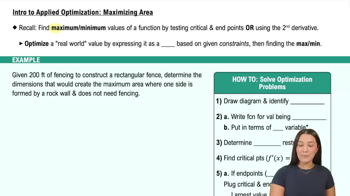30. Find a positive number for which the sum of its reciprocal and four times its square is the smallest possible.
Table of contents
- 0. Functions7h 54m
- Introduction to Functions16m
- Piecewise Functions10m
- Properties of Functions9m
- Common Functions1h 8m
- Transformations5m
- Combining Functions27m
- Exponent rules32m
- Exponential Functions28m
- Logarithmic Functions24m
- Properties of Logarithms36m
- Exponential & Logarithmic Equations35m
- Introduction to Trigonometric Functions38m
- Graphs of Trigonometric Functions44m
- Trigonometric Identities47m
- Inverse Trigonometric Functions48m
- 1. Limits and Continuity2h 2m
- 2. Intro to Derivatives1h 33m
- 3. Techniques of Differentiation3h 18m
- 4. Applications of Derivatives2h 38m
- 5. Graphical Applications of Derivatives6h 2m
- 6. Derivatives of Inverse, Exponential, & Logarithmic Functions2h 37m
- 7. Antiderivatives & Indefinite Integrals1h 26m
- 8. Definite Integrals4h 44m
- 9. Graphical Applications of Integrals2h 27m
- 10. Physics Applications of Integrals 3h 16m
- 11. Integrals of Inverse, Exponential, & Logarithmic Functions2h 31m
- 12. Techniques of Integration7h 41m
- 13. Intro to Differential Equations2h 55m
- 14. Sequences & Series5h 36m
- 15. Power Series2h 19m
- 16. Parametric Equations & Polar Coordinates7h 58m
5. Graphical Applications of Derivatives
Applied Optimization
Problem 4.5.10
Textbook Question
10. Catching rainwater A 1125 ft^3 open-top rectangular tank with a square base x ft on a side and y ft deep is to be built with its top flush with the ground to catch runoff water. The costs associated with the tank involve not only the material from which the tank is made but also an excavation charge proportional to the product xy.
a. If the total cost is c=5(x^2+4xy) + 10xy, what values of x and y will minimize it?
b. Give a possible scenario for the cost function in part (a).
 Verified step by step guidance
Verified step by step guidance1
Step 1: Understand the problem. We need to minimize the cost function c = 5(x^2 + 4xy) + 10xy, where x is the side length of the square base and y is the depth of the tank. The volume of the tank is given as 1125 ft^3, which provides a constraint: x^2 * y = 1125.
Step 2: Express y in terms of x using the volume constraint. From x^2 * y = 1125, solve for y to get y = 1125 / x^2.
Step 3: Substitute y = 1125 / x^2 into the cost function c. This gives c = 5(x^2 + 4x(1125 / x^2)) + 10x(1125 / x^2). Simplify this expression to get a function of x only.
Step 4: Differentiate the cost function with respect to x to find the critical points. Set the derivative equal to zero and solve for x. This will give the value of x that minimizes the cost.
Step 5: Use the second derivative test to confirm that the critical point found is indeed a minimum. Then, substitute the value of x back into y = 1125 / x^2 to find the corresponding value of y.
 Verified video answer for a similar problem:
Verified video answer for a similar problem:This video solution was recommended by our tutors as helpful for the problem above
Video duration:
7mPlay a video:
Was this helpful?
Key Concepts
Here are the essential concepts you must grasp in order to answer the question correctly.
Optimization in Calculus
Optimization involves finding the maximum or minimum values of a function within a given domain. In this problem, the goal is to minimize the cost function c = 5(x^2 + 4xy) + 10xy, which represents the total cost of building the tank. This requires using techniques such as setting the derivative of the cost function to zero to find critical points and determining which of these points yields the minimum cost.
Recommended video:

Intro to Applied Optimization: Maximizing Area
Partial Derivatives
Partial derivatives are used to analyze functions of multiple variables, like c(x, y) in this problem. They measure how the function changes as one variable changes while keeping others constant. To minimize the cost function, we need to find the partial derivatives with respect to x and y, set them to zero, and solve the resulting system of equations to find the values of x and y that minimize the cost.
Recommended video:

Derivatives
Critical Points and Second Derivative Test
Critical points occur where the first derivative (or partial derivatives) of a function is zero or undefined. To determine if these points are minima, maxima, or saddle points, the second derivative test is used. For functions of two variables, this involves evaluating the Hessian matrix at the critical points. If the Hessian is positive definite, the point is a local minimum, which is crucial for confirming the minimum cost configuration in this scenario.
Recommended video:

The Second Derivative Test: Finding Local Extrema

 1:13m
1:13mWatch next
Master Intro to Applied Optimization: Maximizing Area with a bite sized video explanation from Patrick
Start learningRelated Videos
Related Practice
Textbook Question
